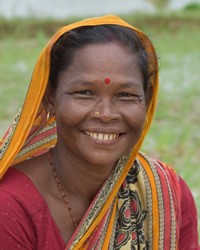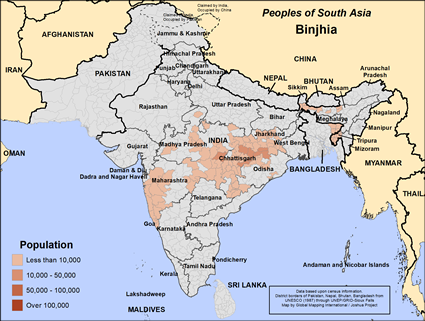Binjhia in India

Photo Source:
debjanixyz - Pixabay
|

Map Source:
People Group data: Omid. Map geography: UNESCO / GMI. Map Design: Joshua Project.
|
| People Name: | Binjhia |
| Country: | India |
| 10/40 Window: | Yes |
| Population: | 181,000 |
| World Population: | 187,900 |
| Primary Language: | Hindi |
| Primary Religion: | Hinduism |
| Christian Adherents: | 0.45 % |
| Evangelicals: | 0.00 % |
| Scripture: | Complete Bible |
| Ministry Resources: | Yes |
| Jesus Film: | Yes |
| Audio Recordings: | Yes |
| People Cluster: | South Asia Tribal - other |
| Affinity Bloc: | South Asian Peoples |
| Progress Level: |
|
Introduction / History
The Binjhia people are labeled a scheduled tribe in India. This means that their status is low, and they viewed as tribals, not fully in the mainstream of society. Though they once were scattered throughout central India, today they are mostly in Odisha and Jharkhand.
What Are Their Lives Like?
Most of the Binjhia are farmers. For them, land has both economical value and social status. Many of the Binjhia have no land of their own, and work others' land as hired laborers. Some work on a daily wage basis, while others work on yearly contracts. The daily laborers are either paid in cash or in rice. Their main crop is rice, grown in a flooded field. They also grow some vegetables such as tomatoes, chilies, cucumbers, and pumpkins. They learned their farming techniques from neighboring Hindu tribes. Their women do the weeding. The Binjhia are basically self-sufficient, living on what they raise in their gardens. Although they do not depend on the weekly markets for their food, they visit the markets to purchase items such as salt, kerosene, tobacco, dried fish, and cloth. Their women are most active in any financial decisions and transactions. They often resort to the barter system of exchanging goods. Binjhia women love to wear jewelry such as bracelets, necklaces, and armlets made of silver, brass, and beads. Beaded necklaces are their favorite. Binjhia men and women must wait until they are adults before they are married. Marriages are not arranged; young adults are free to choose their own mates. Weddings always begin on Sundays and last for several days. Each family lives in one or two roomed mud houses with thatched roofs. The tiny huts line both sides of the main village street. Overall, their living conditions are not very sanitary. Their goats and fowl are allowed to roam freely inside. Elderly villagers deal with any social issues or conflicts that arise. All adult villagers work together to come up with a final decision.
What Are Their Beliefs?
Because the Binjhia have had much contact with Hindus, they are classified as a Hindu tribe. Though they have adopted many Hindu gods and goddesses, they also practice a form of their own ethnic religion. Their village deity is named Budharaja. Their supreme deity, Bindya Basini, is represented by a stone in the shape of a woman. They believe she looks after their welfare, protecting them from all danger. They also keep many other gods are also kept in their homes. They make regular offerings of raw rice, milk, sweets, liquor, and fruit to these gods. Ancestor worship (praying to deceased ancestors) is another common practice. Because the Binjhia believe that their ancestors are reborn as children, children are worshipped at a festival once a year.
What Are Their Needs?
The Binjhia people need to put their faith in the Supreme, all-powerful God of the Bible, not deities that help to keep them away from the true Lord.
Prayer Points
Pray that the sheer wonder of knowing Jesus and the impact he has on their lives and the joy he brings spur believers to share Christ with the Binjhia people. Pray the hearts of the Binjhia people would be stirred by a sovereign work of the Holy Spirit readying them for the time when they hear the gospel message being shared with them. Pray they will experience dreams and visions of Jesus leading them into a saving relationship with Him. Pray for an unstoppable movement to Christ among the Binjhia people.